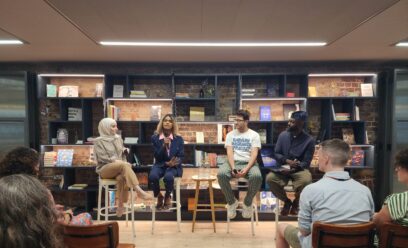How to talk about safe routes
Posted by Julia Rampen on February 1, 2023With a General Election looming, IMIX’s Media Director Julia Rampen writes about how we can talk about the concept of safe routes in a way that gives us the best chance of winning over key voter demographics in the UK.

Source: Flickr
“The best way to stop people making dangerous journeys across the Channel is to create safe routes for refugees.”
Many of us have said some version of the above statement to journalists over recent years, or shared a similar sentiment on social media. But what does it actually mean, especially to someone who like most of the British public has taken safe routes all their life?
After all, the most popular destinations for Brits abroad are Spain, France and Italy. Only one of the top ten destinations includes paperwork at all (the US) and even then, for British citizens going on holiday, it’s just an online form. In other words, if you have personal experience of how nail-biting applying for a visa to work, travel or study is, you’re in the minority.
Meanwhile, every day, the mass media reports on – to directly quote the Daily Mail – “illegal Channel migrants” as if the people crossing the world’s busiest shipping lane had somehow considered, and turned down, other options.
We wanted to find clear ways to talk about safe routes – or more precisely, the lack of them – to the majority. While safe routes will never be able to respond to all eventualities in which people seek safety, a government commitment to open up more channels for refugees would undoubtedly change lives. Furthermore, their absence has not stopped the government pressing forward with legislation which undermines the Refugee Convention and other humanitarian law.
Working with More In Common, we put the question, ‘Do you know what safe routes are?’ to two focus groups in two marginal constituencies likely to be electoral battlegrounds in the next General Election.
When it comes to views on immigration and refugees, study after study finds roughly a quarter of the population strongly in favour, a quarter strongly opposed, and half undecided – often known as the ‘mixed middle’. Taking the temperature of these voters is extremely useful in thinking through how we communicate to them in our projects and campaigns – even though some of what they express may feel uncomfortable to us. Winning over these voters is also a priority of any ambitious politician, so understanding them is useful when trying to persuade political parties to take a more humane stance on immigration and asylum.
When we asked about safe routes, the first reaction was usually a shrug or a blank face. But when the discussion moved on to Channel crossings, many participants offered suggestions that were, effectively, safe routes. As one participant put it:
“There is quite a lot of spare work in the country and if people are willing to come here and work, I don’t think anybody would have a problem with that at all… In fact, if we were to legalise it, just allow people to come, people wouldn’t have to come across the Channel in a small boat and we could control it ourselves.”
When asked to imagine safe routes, another described:
“A plane landing rather than a dinghy, a nice plane, people waiting with open arms.”
Several participants mentioned the Homes for Ukraine scheme, but although some shared inspiring stories of refugees who came through the scheme, others focused on the scheme’s flaws.
Interestingly, when it came to the subject of cutting out smugglers, participants were more focused on saving lives. As one person put it:
“The primary [reason] should always be people’s lives, and the fact that they wanted to risk their lives to come over. Of course it’s not good these people are making money from illegally getting people over here, but I don’t think that’s the main issue at all.”
More concerning for participants was the idea that, with no checks at all, criminals could take advantage of the chaos to slip through borders. There was strong support for a system that could respond quickly in a crisis, effectively identify people with a convincing claim, and allow them to work when they arrived.
“Rather than everyone rushing around like headless chickens, as soon as there’s a crisis somewhere, thinking about how we’re going to do it and what we’re going to do, if there’s a policy in place, strict guideline rules… we can respond faster, be more proactive and probably get a better outcome out of the whole thing.”
What was striking was that, far from echoing the dog-whistle rhetoric currently in vogue, the participants in these focus groups emphasised the importance of saving lives, and their main concern was a lack of resources, along with the need to keep the population safe. Many of the experts by experience participating in our workshop addressed these concerns head on, with several emphasising their frustration at being dependent on the system when they would have wished, in the words of one, been allowed to “find a job and have their own place”.
So how do we keep the conversation going on this complex and important issue? There are clearly limits to a policy of safe routes alone, but talking about it brings the focus away from the current denial and dog-whistle rhetoric and back to the emphasis on acknowledging the existence of people seeking safety and the government’s obligation to come up with processes to help them.
Here is some suggested messaging, which was developed in consultation with people with lived experience of irregular journeys, and resonated with the focus group participants as well. Not everyone will want to use all of these messaging tools, and some may not even agree with them. But for those of us focused on winning over the mixed middle, they may form a useful part of a communications strategy.
Message 1: A plan vs chaos
When people escape dangerous situations, we want to make sure they feel safe as soon as possible. They have lost everything, and they need help to start a new life. But there is no refugee visa, and the reality is, if your house is bombed, you may not have time to apply for one anyway. Rather than responding in a panic to the latest crisis, this government could create a safe, organised route which would allow us to help such families directly.
Message 2: Participating from day one
If someone currently in danger wants to come here, work hard and participate in the community, we should give them a chance. But this government has allowed a bureaucratic backlog to build up which means skilled people are forced to sit on their hands for years before getting permission to work. If we invested in a speedier system which could identify refugees when they first need our help, bring them here safely and give them the right to work straight away, they wouldn’t have to risk their lives in a small boat and instead could start to participate in the community straight away.
Message 3: A vision of hope
There’s nothing more important than people’s lives. But currently, the only way for most refugees to ask for our help is to get into a flimsy dinghy to cross the world’s busiest shipping lane. If we worked together with other countries, we could create a system which allows people with a good reason to come here to apply for our help. Then the refugees we welcome could take a normal flight like everybody else. Rather than letting the mess and despair continue, we could create a route of hope.
We will be holding an event to explore this messaging more, so keep a look out for the invite, or email Julia.Rampen@imix.org.uk to express interest.
Meanwhile, read our full report here.



